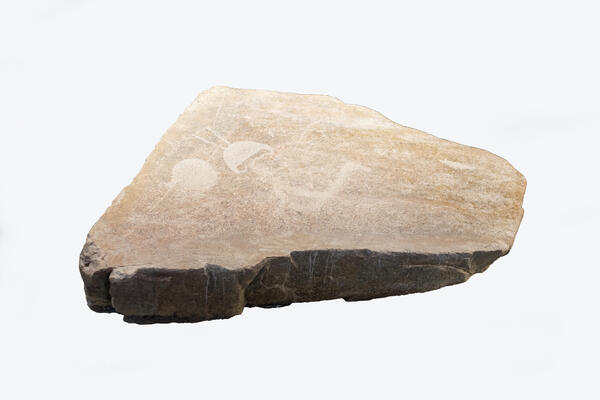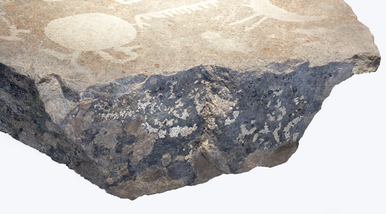A granite slab with petroglyphs is exhibited in the section of the permanent exhibition “Stone Chronicle. The Archaeology of Karelia”. Petroglyphs (from Ancient Greek “petros” meaning “stone” and “glyph” meaning “carving”) are images carved on stones. According to archaeologists, petroglyphs were used for ritual purposes — to please the spirit of a killed animal, for instance. This theory arose after the remains of various animals began to be found near the rock carvings.
The drawings on the granite slab were made on the smooth side — it was polished by waves and ice. The figures have been recognized: the ancient inhabitants of Karelia carved a silhouette of a bird, presumably a duck, and two solar signs — a circle and a semicircle.
The slab with petroglyphs was discovered by the archaeological expedition of Alexander Zhulnikov in 2008. The stone fragment was located on Peri Nos Cape on the eastern shore of Lake Onega.
Petroglyphs are also found in scattered groups on the rocks of Devil’s Nose peninsula, Kladovets capes, Gagazhy and on Gury island, and also on Karetsky Nos and on Kochkov Navolok peninsula near Shalsky village. In total, the section of the shore with petroglyphs stretches for 20.5 kilometers; in total, there are about 1100 figures and signs. Basically, these are images of birds, forest animals, people and boats. The figures are up to four meters large.
Among them there are also mystical images, such as a group of three figures: a demon, a catfish and an otter (lizard). Legend has it that around the 15th century, the monks of the Murom monastery depicted a Christian cross on top of the image in order to disarm the devil.
In July 2021 the Onega petroglyphs were included in the list of UNESCO World Heritage Sites.
These petroglyphs appeared presumably in the Mesolithic period — in the 7th–5th millennium BC. Today more than 300 short-term camps of that period, permanent semi-dugout dwellings, sites for extracting stone raw material and manufacturing tools have been discovered. During the Mesolithic period, the ancient inhabitants of Karelia mastered the first stone technologies — quartz, shale and flint. The main occupations were hunting in the taiga and fishing in the lake.
In addition to this slab, the exhibition presents the inventory of the oldest camp on the territory of Karelia, tools from the stone workshops, reconstructed vessels of New Stone Age, cult objects and amulets from the Oleneostrovsky burial site.
The drawings on the granite slab were made on the smooth side — it was polished by waves and ice. The figures have been recognized: the ancient inhabitants of Karelia carved a silhouette of a bird, presumably a duck, and two solar signs — a circle and a semicircle.
The slab with petroglyphs was discovered by the archaeological expedition of Alexander Zhulnikov in 2008. The stone fragment was located on Peri Nos Cape on the eastern shore of Lake Onega.
Petroglyphs are also found in scattered groups on the rocks of Devil’s Nose peninsula, Kladovets capes, Gagazhy and on Gury island, and also on Karetsky Nos and on Kochkov Navolok peninsula near Shalsky village. In total, the section of the shore with petroglyphs stretches for 20.5 kilometers; in total, there are about 1100 figures and signs. Basically, these are images of birds, forest animals, people and boats. The figures are up to four meters large.
Among them there are also mystical images, such as a group of three figures: a demon, a catfish and an otter (lizard). Legend has it that around the 15th century, the monks of the Murom monastery depicted a Christian cross on top of the image in order to disarm the devil.
In July 2021 the Onega petroglyphs were included in the list of UNESCO World Heritage Sites.
These petroglyphs appeared presumably in the Mesolithic period — in the 7th–5th millennium BC. Today more than 300 short-term camps of that period, permanent semi-dugout dwellings, sites for extracting stone raw material and manufacturing tools have been discovered. During the Mesolithic period, the ancient inhabitants of Karelia mastered the first stone technologies — quartz, shale and flint. The main occupations were hunting in the taiga and fishing in the lake.
In addition to this slab, the exhibition presents the inventory of the oldest camp on the territory of Karelia, tools from the stone workshops, reconstructed vessels of New Stone Age, cult objects and amulets from the Oleneostrovsky burial site.



